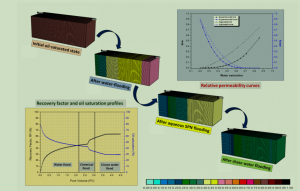Numerical Simulation of Enhanced Oil Recovery (EOR) studies for aqueous Gemini Surfactant-Polymer-Nanoparticle systems
Abstract
The article investigates the efficacy of gemini surfactant/polymer/nanoparticle flooding on chemical EOR. Initially, physico-chemical behavior of aqueous chemical fluids were investigated via interfacial tension reduction, wettability alteration, adsorption, viscosity moderation and oil displacement experiments. During compositional analysis, Cartesian model with specified grid properties, injection flow-rate, well pattern, and rock-fluid characteristics was developed using CMG-STARS tool. Contour map analyses showed that oil saturation decreased from ˜80% (initial) to 31.96%, 30.68% and 29.30% after {14-6-14 GS + chase water}, {14-6-14 GS + PHPA + chase water} and {14-6-14 GS + PHPA + SiO2 chase water} flooding respectively.Tertiary recoveries of 15-19% were achieved, depending on injected fluid composition. Experimental data were history matched via CMOST tool to achieve good matching of simulated results. The CMG flooding simulator provides a holistic approach to investigate oil displacement profiles, assess flooding recovery capabilities with near-accuracy and predict the feasibility of proposed chemical EOR projects.

Conclusions
Laboratory core-flood experiments were simulated using CMG-STARS to investigate the flooding performance of {14-6-14 GS +/ PHPA polymer +/ SiO2 nanoparticle} aqueous fluids. Aqueous chemical systems exhibited ultra-low IFT, rock-wetting behavior and pseudoplastic flow character, as evident from experimental analyses. Surfactant fluids were characterized by micelles/aggregates in bulk phase, which altered to network structure of dispersed micelles interconnected by entangled polymer chains in surfactant-polymer solutions. This structural attribute becomes more pronounced in the surfactant-polymer-nanoparticle (SPN) fluids, resulting in the formation of supra-molecular network structure with enhanced oil-attracting properties. Cartesian single-porosity model was employed to develop a robust numerical approach to match flooding properties of analyzed fluids. Initially, water-flood was simulated for 208 min. After secondary oil recovery, tertiary chemicals were injected to improve oil production and maintain pressure drop within reservoir pore-throats. This flooding process involved chemical injection period of 86 min, and ˜150 min chase-water flooding period. Oil saturation maps showed that oil saturation within core sample decreased to 31.96%, 30.68% and 29.30% of original liquid content at the end of flooding studies, involving {14-6-14 GS}, {14-6-14 GS + PHPA} and {14-6-14 GS + PHPA + SiO2} fluids respectively. Relative permeability curves were adjusted to model flooding results, and proved to be useful in predicting oil displacement results.
Tertiary flooding simulations revealed EOR percentages of 15.06%, 17.42% and 18.49% of original oil in place (OOIP) in the presence of {14-6-14 GS + chase water}, {14-6-14 GS + PHPA + chase water} and {14-6-14 GS + PHPA + SiO2 + chase water} respectively. In summary, the analyzed aqueous fluids exhibit favorable recoveries and economic feasibility for EOR in sandstone rock systems.

